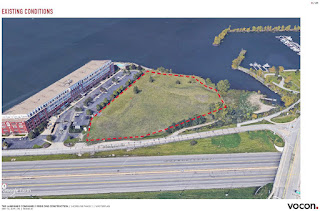 |
| Two Cleveland-area auto plants that were closed earlier this decade could be repurposed into advanced manufacturing and warehousing operations. (FordAuthority.com) CLICK TO ENLARGE ALL IMAGES |
At least one of the game changing technologies is the plasma ignition system, also known as the sparkless ignition, according to a party involved with sales transaction.
The plants are the 1.7-million-square-foot Brook Park Engine Plant No. 2 on Snow Road and the 2.1-million-square-foot Walton Hills stamping plant on Northfield Road.
 |
| Ford's 1.7-million-square-foot Brook Park Engine Plant No. 2 (above) that closed in 2000 and Ford's Walton Hills Stamping Plant (below) that closed in 2015 (Google). |
Sparkless ignitions will replace spark plugs which have been around since the 1800s. Using plasma-based systems to ignite fuel translates to cleaner-burning, more fuel-efficient engines. Most manufacturers conservatively say sparkless ignitions improve fuel economy by 10 percent, but the potential is for savings as much as 25 or 30 percent.
However, the source could not divulge the buyer's identity. But the information available narrows the focus of who the potential buyer may be, as there are few companies who have the ability and interest to mass produce sparkless ignition systems.
The checklist for helping to identify potential buyers includes a company that:
- Is seeking to mass-produce a sparkless ignition system;
- Has significant financial resources to buy, redesign/retool and sustain two massive manufacturing plants;
- Has significant know-how to redesign/retool them for their production line(s);
- Has existing supplier/buyer relationships to ramp up volume production to fully utilize 3.8 million square feet of plant space in a reasonable period of time;
- Produces other advanced automotive products for next-generation cars that produce low/no emissions, feature self-driving-technologies, etc. since the manufacture of sparkless ignition systems likely won't require the utilization of anywhere near 3.8 million square feet of plant space.
One of the pioneers in the field of sparkless ignitions is Plasma Igniter, LLC which makes the Coaxial Cavity Resonator Ignition System (CCRIS). However, it is a small company with few resources whose small, California-based production line is limited to military applications.
Another possibility might be an existing automobile manufacturer. All automakers are seeking to bring to market cars that offer sparkless ignition systems and other advanced powertrain technologies. However, Ford is unlikely to sell two of its large plants to a competitor -- unless that automaker has an alliance like the one Ford announced with Volkswagen earlier this year.
In December, (Volkswagen CEO Herbert) Deiss said his company may expand its U.S. production presence beyond Chattanooga, Tennessee, by building products in underutilized Ford factories with UAW workers, according to the Detroit Free Press. That would be a significant change -- foreign automakers have avoided U.S. union labor other than a past General Motors-Toyota operation in California that now is the site of Tesla's factory.
But another source who knows who bought the Ford plants would say publicly only that the buyer isn't VW "unless they bought it under another name, but that would be unlikely," the source said.
Tenneco/Federal-Mogul LLC. Federal-Mogul is a company based in the Detroit suburb of Southfield and earns more than $7 billion in revenue per year. Last year, the Chicago-based multinational corporation Tenneco purchased Federal-Mogul for $5.4 billion.
Even more interesting is that newly combined businesses are proposed to be separated in late-2019 into two independent, publicly traded companies -- one an aftermarket auto parts company called Driv and the other a powertrain technology company, to continue to be called Tenneco. The latter has sought to introduce a sparkless ignition system called Advanced Corona Ignition System (ACIS) that Federal-Mogul has been developing and wants to put into volume production.
"Following the separation, the powertrain technology company will be one of the world’s largest pure-play powertrain companies serving OE markets worldwide with engineered solutions addressing fuel economy, power output, and criteria pollution requirements for gasoline, diesel and electrified powertrains," according to a written statement issued Oct. 1, 2018 by Tenneco. "The powertrain technology company would have 2017 pro-forma revenues of $10.7 billion, serving light vehicle, commercial truck, off-highway and industrial markets."
 |
| Ford's Walton Hills plant is located next to Interstates 271/480 as well as Norfolk Southern (Google). |
While its eyes may be bigger than its wallet right now, repurposing the Ford plants offer a relatively affordable way for Tenneco to put sparkless ignitions into mass production. They also offer a means to consolidate their warehousing operations for the eastern U.S. and close down more costly locations on the East Coast. But these aren't necessarily game-changing moves for Greater Cleveland's economy.
The sale of the two Ford plants looks to be close to do a done deal. On May 15, a New York City law firm on behalf of Wilmington Trust Co. filed Uniform Commercial Code Financing Statement Amendments with the Cuyahoga County Fiscal Officer for Ford's Brook Park and Walton Hills plants.
Wilmington Trust, as trustee under some Ford-issued debt instrument, is confirming its interest in the two properties. As part of the sale process and title search, Ford is establishing what encumbrances there may be to a clear title.
END




























